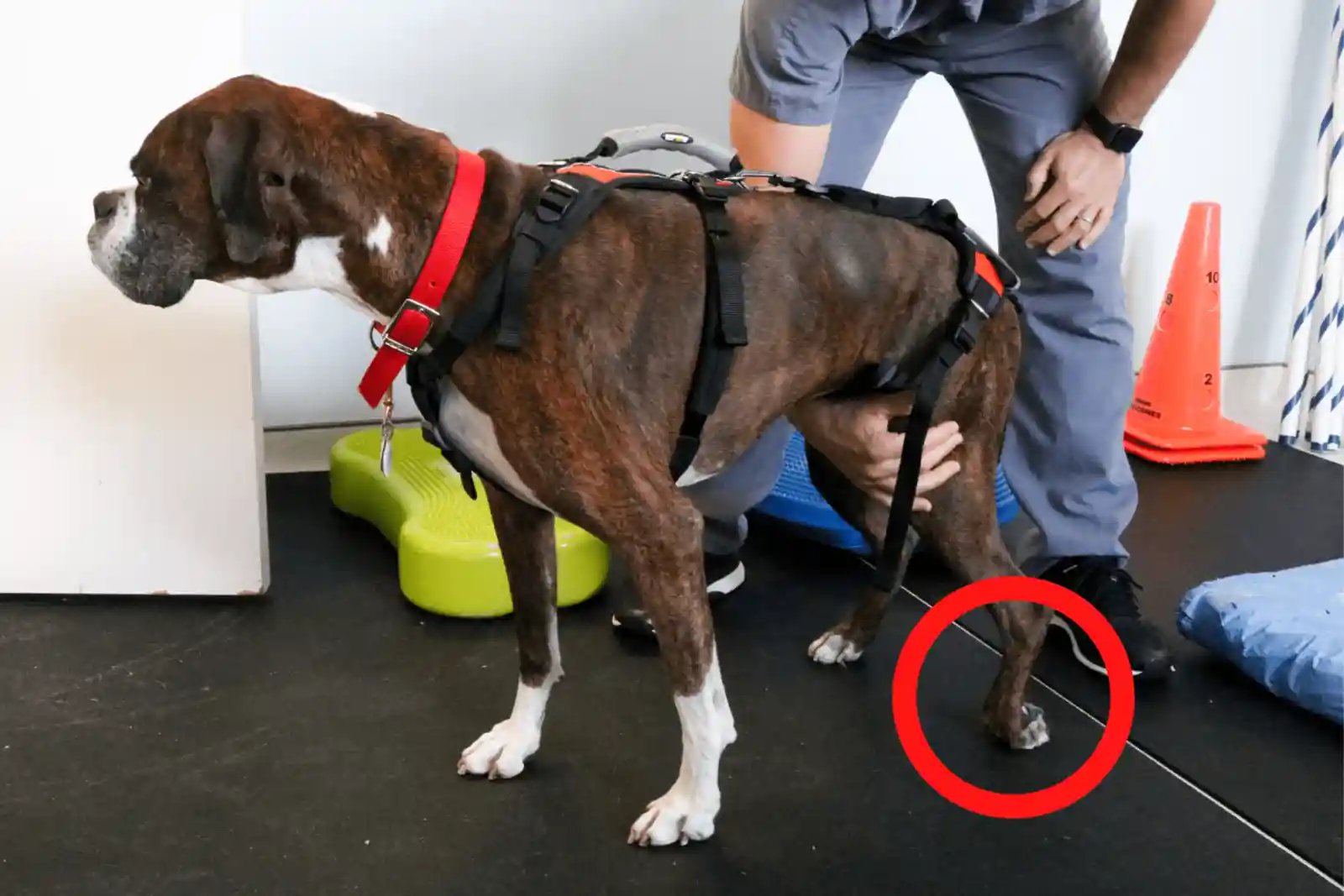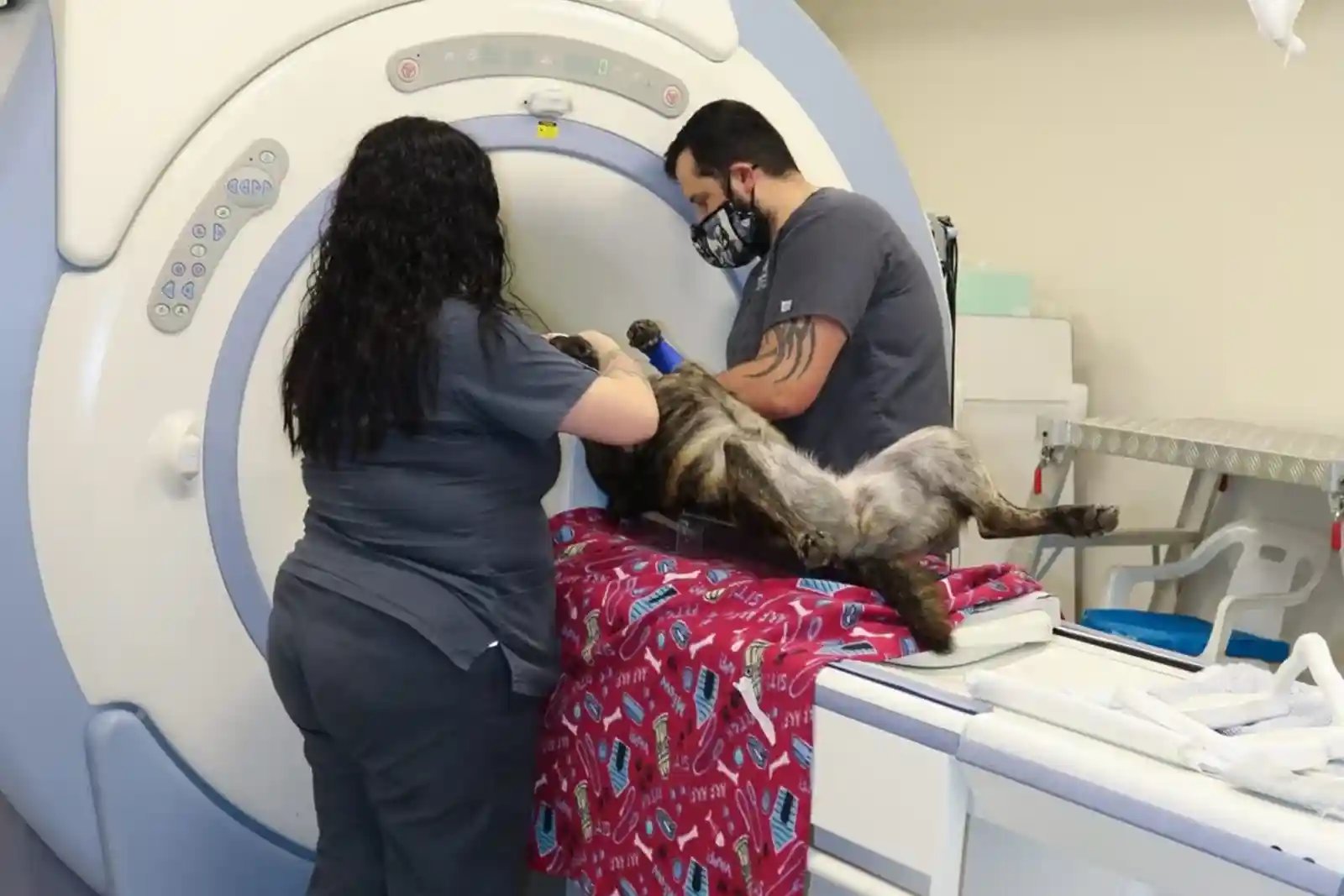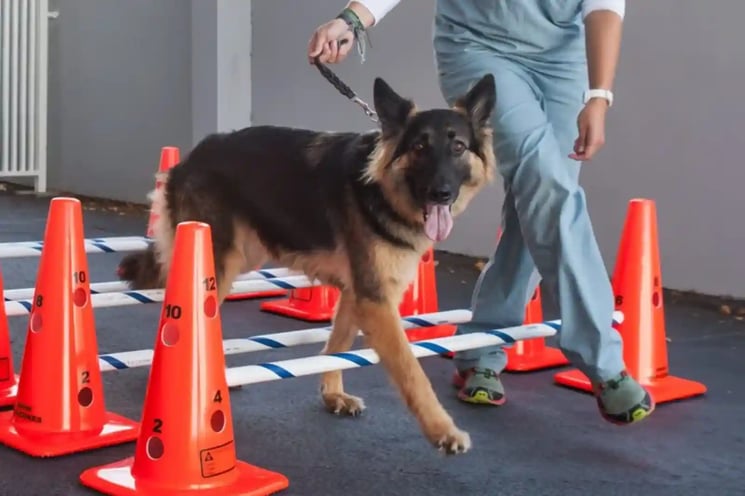Degenerative Myelopathy: Symptoms, Cause, and Treatment
Degenerative myelopathy (DM) is a slowly progressive neurological disease of the spine in dogs. Degeneration means deterioration. Myelopathy is any problem with the spinal cord. So, degenerative myelopathy means deterioration of the spinal cord. The spinal cord carries information from the brain, down the neck, along the back, to the limbs and tail, and then back up to the brain. As a dog’s spinal cord begins to deteriorate from DM, there is a reduction in nerve signals to the muscles in the hind limbs, typically causing hind limb weakness to be the first visible symptom.
The spinal cord carries information from the brain, down the neck, along the back, to the limbs and tail, and then back up to the brain. As a dog’s spinal cord begins to deteriorate from DM, there is a reduction in nerve signals to the muscles in the hind limbs, typically causing hind limb weakness to be the first visible symptom.
“This process has been compared to ALS in humans, also known as Lou Gehrig’s disease,” notes Dr. Michael Wong, founder and veterinary neurologist at Southeast Veterinary Neurology (SEVN).
What Causes Degenerative Myelopathy?
It wasn’t that long ago that we didn’t know what caused DM, but we now recognize degenerative myelopathy as a genetic condition. We usually see it in certain breeds, and it tends to be more prevalent in larger dogs, but it can affect a variety of breeds.
Some common breeds affected by degenerative myelopathy are:
- German Shepherds
- Boxers
- Collies
- Siberian Huskies
- Wirehaired Fox Terriers
- Standard and Miniature Poodles
- Pembroke Welsh Corgis
- Bernese Mountain Dogs
- Kerry Blue Terriers
- Chesapeake Bay Retrievers

What are Signs of Degenerative Myelopathy?
Degenerative myelopathy comes on slowly as a dog ages, often around eight to ten years old. Since DM occurs in the spinal cord of the back, we classically observe rear limb weakness and incoordination as primary symptoms.
Signs of degenerative myelopathy typically observed at the time of examination include:
- Slow onset and progression
- Weak back legs that are wobbling, scuffing, or crisscrossing
- May be symmetrical or asymmetrical
- Strong front legs
- Ambulatory (still able to walk)
- Normal reflexes
- No sign of pain

At the time of diagnosis, most dogs have been experiencing symptoms of weakness for about six months. Unfortunately, dogs will continue to become weaker over the next 12 months or so, until they can no longer walk. The next stage of DM will usually be urinary and fecal incontinence. Eventually, the front legs will be affected, and cranial nerve signs, such as difficulty swallowing, will develop. Soon after, difficulty breathing will arise, and ultimately, the disease will result in complete paralysis if left alone.
How is Degenerative Myelopathy Diagnosed?
Professional diagnosis is crucial because something as different as an orthopedic issue can look like degenerative myelopathy at first glance.
For example, arthritis also occurs in older, larger dogs and causes trouble walking. And sometimes, a dog will actually have both problems. So how can we tell the difference between an orthopedic and a neurological problem?
“In dogs with orthopedic issues, we see more of a lameness, where they don’t want to put weight on the limbs, are slow to get up, and are worse after resting. Degenerative myelopathy and spinal cord problems aren’t worse after lying down; and instead of aversion to bearing weight, we see incoordination, paw knuckling or dragging of the toes, crisscrossing of the back legs, etc.,” explains Dr. Wong.
That said, the neurological exam will help differentiate between the two. However, there are various neurological conditions that can begin with hind leg weakness, such as spinal cord tumors, malformations, subarachnoid diverticula, or even a slipped disc in a stoic dog.
“It is important to note here that the only true way to diagnose degenerative myelopathy is by performing a spinal cord biopsy, which we do not do, as this is too risky of a procedure in live dogs. So degenerative myelopathy is typically a diagnosis of exclusion, and MRI is the best way to rule out any other neurological possibilities,” adds Dr. Wong.
While there is a genetic test available, it really only tells us if a dog is at risk of developing DM and is not enough on its own to diagnose it. It is only one step in the process.
At SEVN, the steps to diagnosing degenerative myelopathy are:
- Signalment: Is this dog the appropriate breed and age?
- History: Is the story the owner tells us appropriate as far as onset?
- Neurological Exam: Are the clinical signs indicative of a non-painful mid-back spinal cord problem?
- MRI and possible Spinal Fluid Analysis: Is there any other possible cause?
- Genetic Test: Does this dog have the potential to develop degenerative myelopathy?

Can Degenerative Myelopathy be Treated?
Sadly, there is no cure for degenerative myelopathy. Without intervention, DM will prove fatal once it reaches the diaphragm, which controls breathing. Therefore, a peaceful, pain-free passing via humane euthanasia is recommended once a dog’s quality of life is affected, and this will be a different point for each family.
However, there are some things you can do to make your dog more comfortable while living with degenerative myelopathy. At Southeast Veterinary Neurology, we strongly recommend physical therapy. Regular exercise can help reduce atrophy in weakened muscles and give you more time with your dog.
In the meantime, degenerative myelopathy can be managed by:
- Physical therapy
- Soft, padded bed to avoid pressure sores
- Slings to help you get your dog up
- Booties for traction to keep your dog from slipping
- Wheelchair to help your dog get around
- Wagon to help you transport your dog

Contact a Veterinary Neurologist for Hind Limb Weakness in Your Dog Which Could Be a Sign of Degenerative Myelopathy
Dogs whose weak back legs make it difficult to walk should always be examined by a veterinary neurologist. Limb weakness can indicate a disruption in communication between the spinal cord and the brain. Early diagnosis and treatment always provide patients with the best possible outcome.
Southeast Veterinary Neurology is open 365 days a year for neurological emergencies in Miami, Boynton Beach, Jupiter and Virginia Beach! Contact our team for more information about degenerative myelopathy by calling any of our locations!